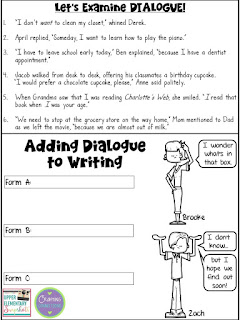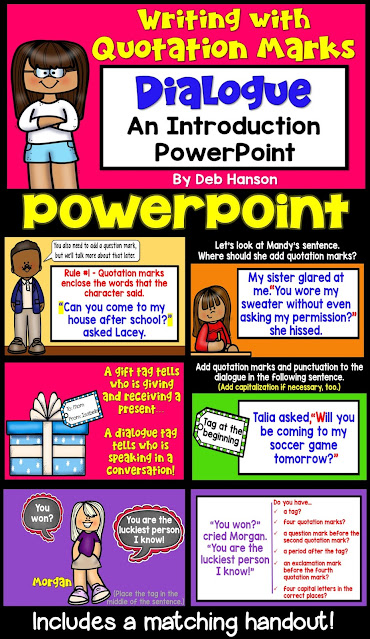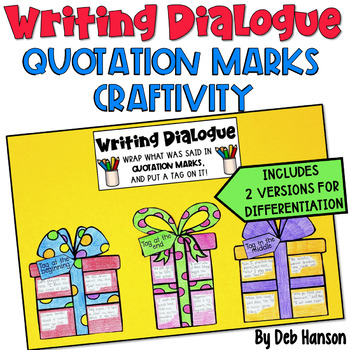When my students enter the classroom on the day of this lesson, they always spot the gift right away, because I display it in a prominent location. Curious students immediately ask me why it's there, and I tell them that they will learn the answer to that question during writing. That usually isn't the answer they want to hear, but I keep them in suspense anyway.
Introduction/Anticipatory Set:
When writing finally begins, I ask students if they have any predictions as to why I brought a gift to school, and how it might be related to today's writing lesson. (I love hearing their creative answers!) Eventually, I point out the gift tag, and tell them that this little tag is the vital piece of this activity. We discuss the purpose of any gift tag: to tell who is giving the gift and who is receiving a gift. Next, I explain that writers often use tags in their writing in a similar way. When writers add dialogue to their stories, they use tags to tell who is speaking at a particular point in the story.Direct Instruction/Guided Practice of Adding Dialogue to Writing:
I instruct my students to get out a yellow highlighter (or marker) and a red pen while I hand out the following sheets of paper. I display my sheet beneath the document camera, and tell students to look at the top half of the paper. For each item, we begin by highlighting the dialogue, and then we circle the tag with our red pens. As you can see, I use the last three items to show students that a tag can be longer than two words. In fact, tags sometimes provide additional information, but its main purpose is still to tell which character is talking in the story.
After we complete #6, we look at what we've highlighted and circled, and conclude that there are three "formulas" that authors use when they write dialogue:
1. An author can place the tag AFTER the dialogue.
2. An author can place the tag BEFORE the dialogue.
3. An author can place the tag in the MIDDLE of the dialogue.
Next, I tell the students that we're going to make our own mini anchor chart on the bottom half of our paper. The finished paper looks like this: |
| Click on the image to download this free printable! |
Wrapping up the Dialogue Lesson:
Finally, it's time to find out what's in the box! Of course, you can choose anything you want to put in the box. Maybe you want to add some fun new revising pens to your writing center. Perhaps you have a new book to share with the class. This time, I chose to share candy with students because I couldn't resist buying a bag when it was on clearance after a recent holiday.
Before I hand out the candy, I ask my students to discuss with a neighbor how this gift was related to writing dialogue. After a quick review, I tell students to put their mini anchor chart in their writing folders because I will expect them to refer to this chart when they revise and edit their writing. Starting today, I will expect them to correctly punctuate dialogue in their pieces of writing.
Exit Ticket/Independent Practice:
As an exit ticket activity, I have my students retrieve a novel from their desk or the classroom library. They must find an example of each dialogue form in their book, and record the three examples on a sheet of paper. I also ask them to highlight the dialogue and circle the tag in red pen, just as we did on the top of the worksheet.
If you are looking for additional resources for teaching dialogue to your upper elementary students, feel free to check out the following resources.
Finally, I invite you to hop over to my blog, Crafting Connections, to read about 8 of my favorite methods for building anticipatory set into my lessons.
Thanks for stopping by today!








